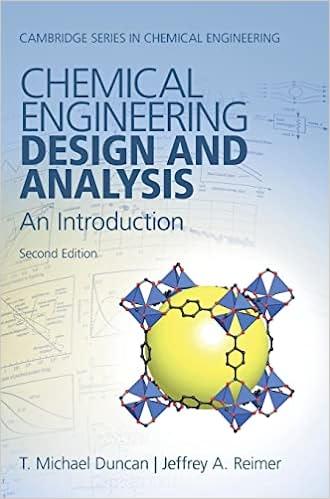Question
Problem statement: Compressors are used to increase the pressure of a gas. Pumps are used to increase the pressure of a liquid. In general, it
Problem statement:
Compressors are used to increase the pressure of a gas. Pumps are used to increase the pressure of a liquid. In general, it is less expensive to pump a liquid than to compress a gas; therefore, in chemical plants, it is generally less expensive to change phase to a liquid or maintain the liquid phase before increasing the pressure. However, there are times when compressors cannot be avoided. For example, when using air as a source of oxygen in oxidation reactions, air must be compressed if the reaction requires high pressures. When a gas is compressed, its density increases, but the temperature rises, lowering the density of the gas somewhat. You will learn later that the least expensive gas to compress is gas that is already compressed, a definite conundrum, because as gas pressure increases the gas density increases. One method to reduce compression cost is to stage the compressors. This is illustrated in Figure. If multiple, staged compressors are used with intercooling, the temperature increase can be reduced, which keeps the gas density high and lowers the compression cost. The disadvantage is the extra equipment cost.

When designing a staged compression system, it is necessary to minimize the cost of the system. This cost is termed the Equivalent Annual Operating Cost (EAOC), and it is given as Equation. This cost includes one-time purchase costs for the compressor(s) and heat exchanger(s), the continuous operating (utility) costs (UCi) for the cooling water used in the heat exchangers and for the electricity to run the compressors. The terms in [ ] show the units for the calculation.

The term (A/P,i,n) is the factor to convert the one-time purchase cost of equipment into an equivalent annuity. You should assume that the effective annual interest rate, i, is 7% p.a., and that the length of the project, n, is 10 years. The equation for (A/P,i,n) is:

You are to optimize a compression system by determining the optimum number of stages. A stage consists of one compressor and one intercooler, with no cooler for a single-stage compressor or after the last compressor. Therefore, for n stages of compression, there are n 1 coolers. The feed to the first compressor is air at 25C. The goal is to compress 4000 kg/h air (Cp = 1.0 J/g K) from atmospheric pressure (assume to be 1 bar = 100 kPa) to 30 bar. As a general rule, the compression ratios (Pout/Pin) for all staged compressor are equal. Cooling water (Cp = 4.184 J/g K) is used in the heat exchangers to cool the air, and the cooling water enters at 30C and is returned at 40C. For the first optimization, assume that the compressed air exiting any intercooler is at 50C, and determine the optimum number of compressor stages. Then, continue the optimization to determine both the optimum number of compressor stages and the optimum air temperature exiting each intercooler (assume all are the same).

The cost of electricity to run the compressors (UCelec[$/y]) can be calculated from the power in Equation 3 and the cost of electricity, which is 0.07/kWh. A year is assumed to be 8000 h, which allows for about one month of plant shut down for maintenance.


Requirments:
You should present your final results as three plots. The first should show how each term in Equation 1 changes with the number of stages, and the second should show the optimization for a constant compressor stage inlet temperature of 50C after the first compressor. The third should show the two-variable optimization for number of compressor stages and compressor stage inlet temperature. These problems can be solved using typical software used by students such as Excel and Matlab etc.
Figure 1: Single- and Multi-stage Compressor Systems EAOC[$/y]=i=12PCi[$](A/P,i,n)[1/y]+i=12UCi[$/y] Eq1 (A/P,i,n)=(1+i)n1i(1+i)n The power required to run a compressor is W[W]=3600m[kg/s](ToutTin) where m is the mass flowrate of air, the temperatures are in Kelvin, and Tout=Tin(PinPout)0.286 The purchased cost of each compressor is given by: PCcomp[$]=$15.9(W[W])0.8 The design equation for the heat exchanger is given by: Q[W]=mair[kg/s]Cp,air[J/kgK](Tair,inTair,out)=mcw[kg/s]Cp,cw[J/kgK](Tcw,outTcw,in)=U[W/m2K]A[m2]FTlm where Tlm=ln(Tair,outTcw,in)(Tair,inTcw,out)(Tair,inTcw,out)(Tair,outTcw,in) and F=0.8 (assume that this is constant for all cases) U= overall heat transfer coefficient =100W/m2K The cost of the heat exchanger is based on its area, which can be calculated by solving for A. The cost equation is PChx[S]=$12,000(A[m2])0.57 The cost of cooling water is given by: UCcw[S/h]=2.5mcw[kg/s]Step by Step Solution
There are 3 Steps involved in it
Step: 1

Get Instant Access to Expert-Tailored Solutions
See step-by-step solutions with expert insights and AI powered tools for academic success
Step: 2

Step: 3

Ace Your Homework with AI
Get the answers you need in no time with our AI-driven, step-by-step assistance
Get Started


